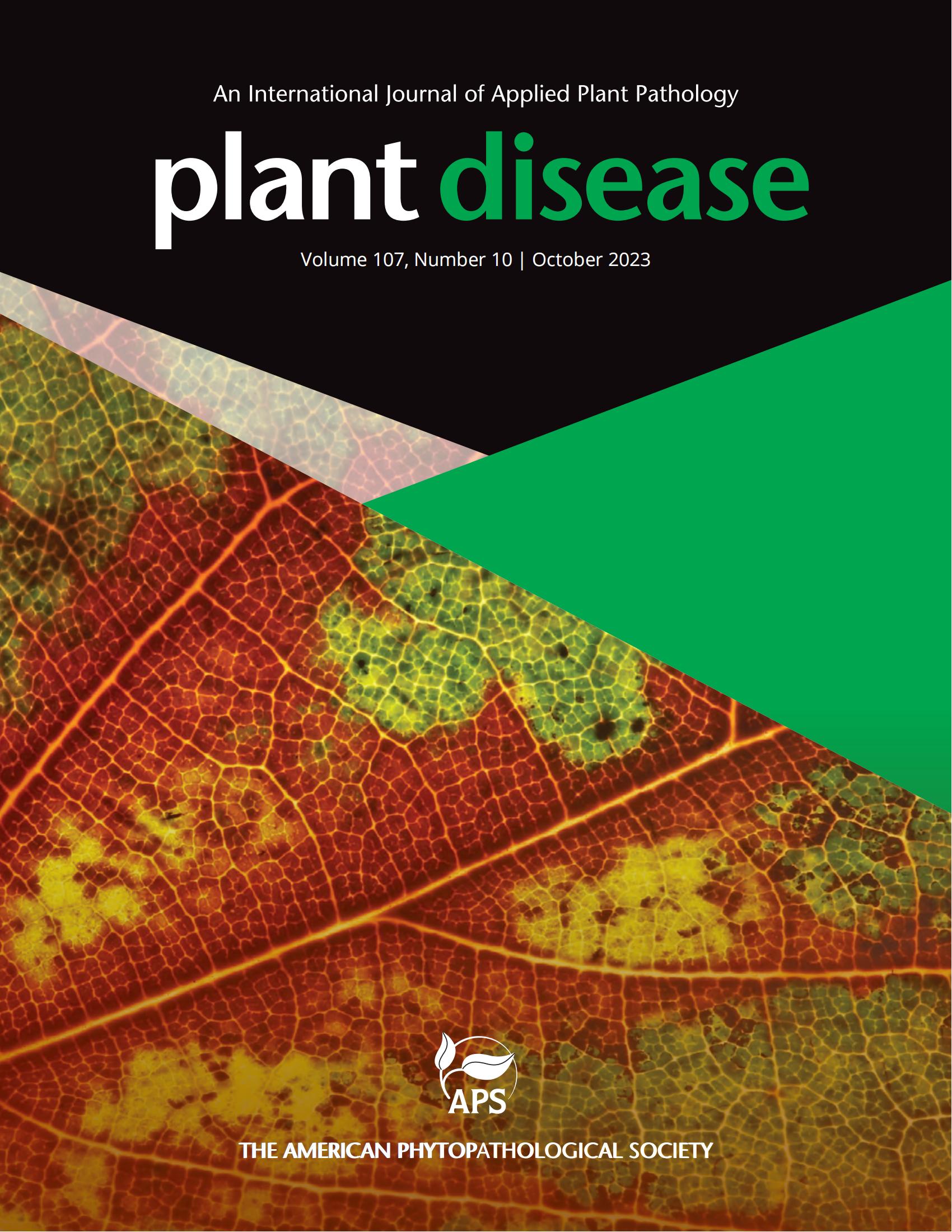中国首次报告 Lelliottia amnigena 在紫茎芥上引起软腐病。
摘要
中国长江流域广泛种植紫茎芥(Brassica rapa subsp.2023 年 2 月,在中国湖北省武汉市(30.41°N,114.22°E)的多块紫茎芥种植田中发现了软腐病。种植区(5 公顷)的发病率接近 20%至 30%,造成了严重的经济损失。受感染的植株叶柄基部出现水渍状症状,散发出恶臭的软腐气味。严重感染的叶柄、茎和根部出现化脓症状,导致植株死亡。为确定病原体,从坏死病变边缘剪下一小块有软腐症状的组织,用 75%(v/v)乙醇进行表面消毒 30 秒,然后用无菌蒸馏水连续冲洗三次。将剪下组织的渗出液进行连续稀释,然后放入营养琼脂(NA)平板上培养,在 28°C 下培养 48 小时,以获得纯化的菌株(Koike 等人,2002 年)。经过培养,共获得 15 株菌株,所有菌株的菌落均为革兰氏阴性、需氧、小、圆、凸起、白色至暗白色,边缘光滑粘滑。从三个不同的病菌样本中分别分离出 CT020801 - CT020803 三株细菌作为代表菌株进行进一步研究。使用 BIOLOG GENIII 微孔板系统(Biolog,Hayward,CA,USA)进行的生化检测显示,这些菌株在甲基红、果胶、糊精、D-纤维二糖、β-半乳糖苷酶、柠檬酸盐和麦芽糖检测中呈阳性,但在吲哚、精氨酸二水解酶、脲酶、鸟氨酸脱羧酶和明胶酶检测中呈阴性。以 Lelliottia amnigena NCTC12124T 的基因组 DNA 为模板,用专门设计的引物扩增 16S 核糖体 RNA 基因和三个看家基因 atpD、rpoB 和 recN。所有扩增片段都进行了测序,并存入 GenBank,登录号分别为 OQ954706-OQ954707、OQ954713 和 OQ953873-OQ953881。16S rRNA、atpD、rpoB 和 recN 序列的 BLAST 比对结果显示,CT020801-03 菌株的序列与 L. amnigena 的一致性最高(分别为 100%、≥97.97%、≥98.85% 和≥94.52%)(图 S2)。基于多焦点序列联合 16S rRNA - atpD - rpoB - recN 的系统发生树分析表明,CT020801 - CT020803 与 L. amnigena 聚为同一支系(Carrie 等,2013 年)。这些结果与 Lelliottia amnigena 的报告结果一致(Osei 等人,2022 年)。为确认致病性,用 20 μL 细菌悬浮液(约 108 CFU/mL)刺穿三周龄紫茎芥幼苗的健康基部叶柄,然后在 28°C 和 80% 相对湿度下置于生长室中培养。无菌液体 NB 培养基作为阴性对照。试验重复三次,每次处理五株秧苗。三天后,接种植株的茎基部出现软腐症状,与田间观察到的最初症状一致。对照植物没有出现任何症状。从出现症状的植株中成功地重新分离出了菌株,并鉴定为 L. amnigena,符合科赫假说。L. amnigena 属于肠杆菌属(Birlutiu 等人,2023 年;Brady 等人,2013 年;Izard 等人,1981 年),常见于土壤中,已被确定为导致植物软腐病的机会性病原体(Reyes-García 等人,2020 年;Schroeder 等人,2009 年;Wu 等人,2023 年)。以前的研究已将 L. amnigena 与中国马铃薯块茎软腐病联系起来。然而,本研究标志着中国首次记录到 L. amnigena 导致紫茎芥软腐病的病例。这一发现扩大了该病原菌的已知寄主范围,将有助于为采取有效措施控制该病害提供重要信息。The purple stem mustards (Brassica rapa subsp. chinensis var. purpuraria) (Govaerts R, 2003) are widely cultivated along Yangtze River Valley in China, which is famous for its flavorful and nutritious edible stalks (Wang et al., 2022). In February 2023, a disease of soft rot was observed in multiple purple stem mustards planting fields in Wuhan city, Hubei province, China (30.41°N, 114.22°E). Disease incidence rates were almost 20 to 30% in the planting area (5 ha in size), causing severe economic loss. Infected plants displayed water-soaked symptoms at the base of the petioles, emitting a foul soft rot odor. The severely infected petioles, stems and roots exhibit pus symptoms leading to plant death. To identify the causal agent, small pieces of soft rot symptomatic tissue were cut from the margin of necrotic lesions and surface disinfected with 75% (v/v) ethanol for 30 seconds, followed by three successive rinses with sterile distilled water. The exudates from the clipped tissues were serially diluted and then incubated onto nutrient agar (NA) plates to obtain purified strains at 28°C for 48 hours (Koike et al., 2002). After incubation, 15 strains were obtained and the colonies of all strains were Gram-negative, aerobic, small, round, convex, whitish to dull white, and had smooth slimy edges. Three single bacterial strains CT020801 - CT020803, which were individually isolated from three different diseased samples, were selected as representative strains for further study. Biochemical tests using the BIOLOG GENIII microplate system (Biolog, Hayward, CA, USA) revealed that these strains were positive for methyl red, pectin, dextrin, D-Cellobiose, β-galactosidase, citrate, and maltose, but negative for indole, arginine dihydrolase, urease, ornithine decarboxylase, and gelatinase tests. The 16S ribosomal RNA gene and the three housekeeping genes, atpD, rpoB, and recN were amplified using genomic DNA of Lelliottia amnigena NCTC12124T as the template, with specially designed primers. All amplified fragments were sequenced and deposited in GenBank with accession numbers OQ954706-OQ954707, OQ954713, and OQ953873-OQ953881. BLAST alignments of the 16S rRNA, atpD, rpoB and recN sequences revealed that the sequences of Strain CT020801-03 exhibited the highest identity (100%, ≥97.97%, ≥98.85% and ≥94.52%, respectively) with L. amnigena (Figure S2). Phylogenetic tree analysis based on multilocus sequence joint 16S rRNA - atpD - rpoB - recN revealed that CT020801 - CT020803 and L. amnigena clustered together in the same clade (Carrie et al., 2013). These results were consistent with those reported for Lelliottia amnigena (Osei et al., 2022). To confirm pathogenicity, healthy base petioles of three-week-old purple stem mustards seedlings were stab inoculated with 20 μL bacterial suspensions (approximately 108 CFU/mL) and then incubated at 28°C and 80% relative humidity in a growth chamber. A sterile liquid NB medium served as the negative control. The test was repeated thrice with each test consisting of five seedlings per treatment. After three days, soft rot symptoms appeared on the stem bases of the inoculated plants, consistent with the initial symptoms observed in the field. Control plants showed no symptoms. The strains were successfully re-isolated from symptomatic plants and identified as L. amnigena, fulfilling Koch's postulates. L. amnigena, a member of the Enterobacter genus (Birlutiu et al., 2023; Brady et al., 2013; Izard et al., 1981), is commonly found in soil and has been identified as an opportunistic pathogen responsible for plant soft rot disease (Reyes-García et al., 2020; Schroeder et al., 2009; Wu et al., 2023). Previous studies have linked L. amnigena to soft rot disease in potato tubers in China. However, this study marks the first documented case of L. amnigena causing soft rot disease in purple stem mustards in China. This discovery expands the known host range of the pathogenic bacteria and will help to provide essential information for making effective measures to manage this disease.

 求助内容:
求助内容: 应助结果提醒方式:
应助结果提醒方式:


